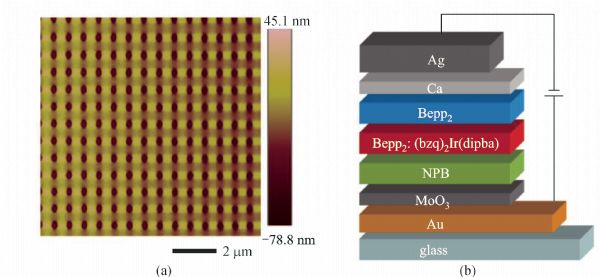

Frontiers of Optoelectronics >
Dual-periodic-microstructure-induced color tunable white organic light-emitting devices
Received date: 31 Jan 2016
Accepted date: 17 Feb 2016
Published date: 05 Apr 2016
Copyright
In this paper, we demonstrate a color tunable white organic light-emitting devices (WOLEDs) based on the two complementary color strategies by introducing two-dimensional (2-D) dual periodic gratings. It is possible to tune the color in a range between cold-white and warm-white by simply operating the polarization of polarizer in front of the microstructured WOLEDs. Experimental and numerical results demonstrate that color tunability of the WOLEDs comes from the effect of the 2-D dual periodic gratings by exciting the surface plasmon-polariton (SPP) resonance associated with the cathode/organic interface. The electroluminescence (EL) performance of the WOLEDs have also been improved due to the effective light extraction by excitation and out-coupling of the SPP modes, and a 39.65% enhancement of current efficiency has been obtained compared to the conventional planar devices.

Yangang BI , Jinhai JI , Yang CHEN , Yushan LIU , Xulin ZHANG , Yunfei LI , Ming XU , Yuefeng LIU , Xiaochi HAN , Qiang GAO , Hongbo SUN . Dual-periodic-microstructure-induced color tunable white organic light-emitting devices[J]. Frontiers of Optoelectronics, 2016 , 9(2) : 283 -289 . DOI: 10.1007/s12200-016-0617-0
| 1 |
D’Andrade B W, Forrest S R. White organic light-emitting devices for solid-state lighting. Advanced Materials, 2004, 16(18): 1585–1595
|
| 2 |
Lee J, Slootsky M, Lee K, Zhang Y F, Forrest S R. An electrophosphorescent organic light emitting concentrator. Light: Science & Applications, 2014, 3: e181
|
| 3 |
Reineke S, Lindner F, Schwartz G, Seidler N, Walzer K, Lüssem B, Leo K. White organic light-emitting diodes with fluorescent tube efficiency. Nature, 2009, 459(7244): 234–238
|
| 4 |
Xiang C Y, Koo W, So F, Sasabe H, Kido J. A systematic study on efficiency enhancements in phosphorescent green, red and blue microcavity organic light emitting devices. Light: Science & Applications, 2013, 2: e74
|
| 5 |
Sun Y, Giebink N C, Kanno H, Ma B, Thompson M E, Forrest S R. Management of singlet and triplet excitons for efficient white organic light-emitting devices. Nature, 2006, 440(7086): 908–912
|
| 6 |
Yu J N, Lin H, Wang F F, Lin Y, Zhang J H, Zhang H, Wang Z X, Wei B. Sunlight-like, color-temperature tunable white organic light-emitting diode with high color rendering index for solid-state lighting application. Journal of Materials Chemistry, 2012, 22(41): 22097–22101
|
| 7 |
Zhao Y, Chen R, Gao Y, Leck K S, Yang X, Liu S, Abiyasa A P, Divayana Y, Mutlugun E, Tan S T, Sun H, Demir H V, Sun X W. AC-driven, color-and brightness-tunable organic light-emitting diodes constructed from an electron only device. Organic Electronics, 2013, 14(12): 3195–3200
|
| 8 |
Huang M H, Lin W C, Fan C C, Wang Y S, Lin H W, Liao J L, Lin C H, Chi Y. Tunable chromaticity stability in solution-processed organic light emitting devices. Organic Electronics, 2015, 20: 36–42
|
| 9 |
Cheng G, Chan K T, To W P, Che C M. Color tunable organic light-emitting devices with external quantum efficiency over 20% based on strongly luminescent gold(III) complexes having long-lived emissive excited states. Advanced Materials, 2014, 26(16): 2540–2546
|
| 10 |
Hu F, Zhang G, Zhan C, Zhang W, Yan Y, Zhao Y, Fu H, Zhang D. Highly solid-state emissive pyridinium-substituted tetraphenylethylene salts: emission color-tuning with counter anions and application for optical waveguides. Small, 2015, 11(11): 1335–1344
|
| 11 |
Thomas K R J, Kapoor N, Bolisetty M N K P, Jou J H, Chen Y L, Jou Y C. Pyrene-fluorene hybrids containing acetylene linkage as color-tunable emitting materials for organic light-emitting diodes. Journal of Organic Chemistry, 2012, 77(8): 3921–3932
|
| 12 |
Keawin T, Sooksai C, Prachumrak N, Kaewpuang T, Muenmart D, Namuangruk S, Jungsuttiwong S, Sudyoadsuk T, Promarak V. Oligoarylenes end-capped with carbazol-N-yl-carbazole as color tunable light-emitting and hole-transporting materials for solution-processed OLEDs. RSC Advances, 2015, 5(21): 16422–16432
|
| 13 |
Bi Y G, Feng J, Liu Y S, Li Y F, Chen Y, Zhang X L, Han X C, Sun H B. Surface plasmon-polariton mediated red emission from organic light-emitting devices based on metallic electrodes integrated with dual-periodic corrugation. Scientific Reports, 2014, 4: 7108
|
| 14 |
Bi Y G, Feng J, Chen Y, Liu Y S, Zhang X L, Li Y F, Xu M, Liu Y F, Han X C, Sun H B. Dual-periodic-corrugation-induced broadband light absorption enhancement in organic solar cells. Organic Electronics, 2015, 27: 167–172
|
| 15 |
Park B, Yun S H, Cho C Y, Kim Y C, Shin J C, Jeon H G, Huh Y H, Hwang I, Baik K Y, Lee Y I. SupUhm H, Cho G S, Choi E H. Surface plasmon excitation in semitransparent inverted polymer photovoltaic devices and their applications as label-free optical sensors. Light: Science & Applications, 2014, 3: e222
|
| 16 |
Koller D M, Hohenau A, Ditlbacher H, Galler N, Reil F, Aussenegg F R, Leitner A, List E J W, Krenn J R. Organic plasmon-emitting diode. Nature Photonics, 2008, 2(11): 684–687
|
| 17 |
Barnes W L, Dereux A, Ebbesen T W. Surface plasmon subwavelength optics. Nature, 2003, 424(6950): 824–830
|
| 18 |
Wedge S, Hooper I R, Sage I, Barnes W L. Light emission through a corrugated metal film: the role of cross-coupled surface plasmon polaritons. Physical Review B: Condensed Matter and Materials Physics, 2004, 69(24): 245418
|
| 19 |
Jin Y, Feng J, Zhang X L, Bi Y G, Bai Y, Chen L, Lan T, Liu Y F, Chen Q D, Sun H B. Solving efficiency-stability tradeoff in top-emitting organic light-emitting devices by employing periodically corrugated metallic cathode. Advanced Materials, 2012, 24(9): 1187–1191
|
/
| 〈 |
|
〉 |